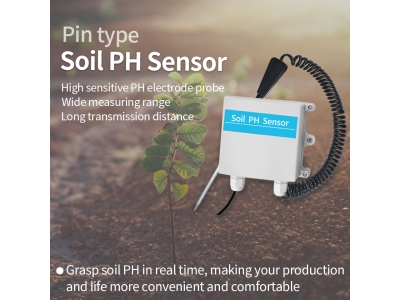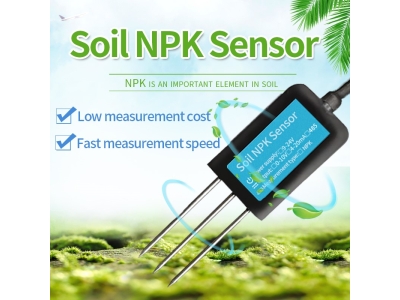In recent years, advancements in technology have revolutionized various industries, and agriculture is no exception. One particular innovation that has significantly impacted farming practices is the use of soil sensors. These sensors provide real-time data and valuable insights about soil conditions, ultimately changing the way we think about farming. This article will explore the benefits and applications of soil sensors, the impact they have on agricultural practices, and their potential to shape the future of farming.
I. Understanding Soil Sensors: What Are They and How Do They Work?

Soil sensors are electronic devices designed to measure and monitor different soil parameters. These parameters include moisture content, temperature, pH levels, salinity, and nutrient levels. The sensors are typically placed in the ground at various depths, allowing them to collect data and transmit it wirelessly to monitoring systems.
Soil sensors work by utilizing different technologies, such as capacitance, resistive, or time domain reflectometry (TDR) methods. Each technology has its advantages, but the key goal is to accurately measure and analyze soil conditions.
II. Benefits and Applications of Soil Sensors:
A. Precision Irrigation: Water is a vital resource in agriculture, and proper irrigation is essential for crop health and yield. Soil sensors enable precision irrigation by measuring soil moisture levels and providing data on when and how much water is needed. This helps farmers optimize water usage, conserve resources, and reduce water-related costs.
B. Nutrient Management: Soil sensors play a crucial role in nutrient management. By measuring nutrient levels in the soil, farmers can determine the appropriate amount and timing of fertilizers. This prevents over- or under-application, reducing the risk of nutrient runoff and ensuring optimal plant nutrition.
C. Disease and Pest Control: Soil conditions can affect the prevalence of diseases and pests in crops. Soil sensors provide valuable data on temperature, moisture, and other environmental factors that influence the presence of pathogens and pests. With this information, farmers can implement preventive measures, such as adjusting irrigation or applying appropriate treatments, leading to improved crop health and reduced yield losses.
D. Crop Monitoring and Yield Optimization: Soil sensors help farmers monitor crop growth and health. By analyzing soil moisture, temperature, and other parameters, farmers can identify early signs of stress, disease, or nutrient deficiencies. This allows for timely interventions and adjustments, resulting in improved crop yields and overall productivity.
III. Impact on Agricultural Practices:
A. Data-Driven Decision Making: Soil sensors provide farmers with precise and real-time information about their fields. This data-driven approach enables informed decision making, leading to more efficient resource allocation, improved crop management, and enhanced productivity.
B. Sustainability and Environmental Stewardship: Soil sensors empower farmers to optimize resource usage and minimize the environmental impact of agriculture. By using precise irrigation and nutrient management practices, they can reduce water usage, fertilizer runoff, and potential soil pollution. This contributes to a more sustainable and environmentally friendly farming system.
C. Cost Reduction: By utilizing soil sensors, farmers can optimize inputs, such as water, fertilizer, and energy. This leads to cost savings by eliminating unnecessary expenses and reducing waste. Additionally, early detection of crop stress or diseases can prevent yield losses, thereby increasing profitability.
IV. The Future of Farming: Soil Sensors as Catalysts for Change
Soil sensors are continually evolving, driven by advancements in technology. The future holds tremendous potential for these sensors to further transform farming practices. Here are some possible developments:
A. Integration with AI and Machine Learning: By combining soil sensor data with AI and machine learning algorithms, farmers can gain deeper insights and predictive capabilities. AI-powered systems can analyze vast amounts of data from multiple sensors, enabling proactive decision making and customized recommendations.
B. Connectivity and Integrated Systems: Soil sensors are likely to become part of a larger interconnected agricultural system. Integrated networks of sensors, drones, and other smart devices can collect data from various sources, providing a comprehensive overview of field conditions. This integration facilitates holistic management and optimization of farming operations.
C. Customization and Crop-Specific Recommendations: With the advancement of soil sensor technologies, personalized recommendations for specific crops may become more accessible. Tailored guidance on factors like irrigation schedules, nutrient management, and crop protection measures can improve crop performance and increase resilience to changing environmental conditions.
Conclusion:
Soil sensors are revolutionizing the way we think about farming. They offer real-time data and insights that enable precision agriculture, improve resource management, and promote sustainable farming practices. As technology continues to advance, soil sensors will play an increasingly vital role in shaping the future of agriculture. By harnessing their potential and embracing data-driven approaches, farmers can optimize productivity, reduce environmental impact, and meet the challenges of a rapidly changing world.






